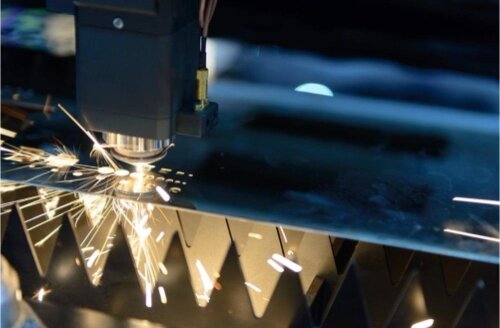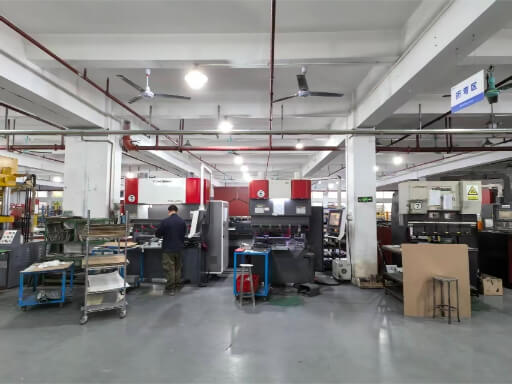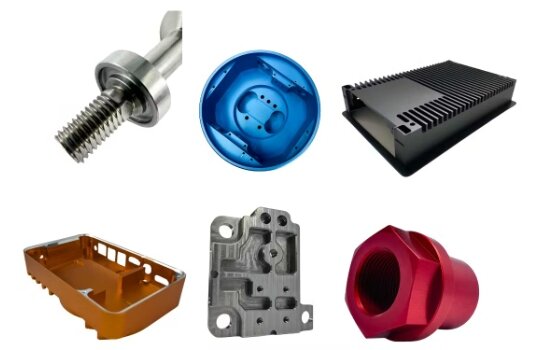Shengen provides precision sheet metal fabrication parts. Have you ever wondered how we produce custom parts of high quality for different industries? Using cutting-edge technologies, such as laser-cutting, is often the answer. This is a fascinating process that embodies the commitment we have to quality, efficiency, and innovation.
Laser cutting is an industrial technique that uses high-powered lasers to cut materials in custom shapes and sizes. This method allows us to cut complex components with an exact cut.
Are you still intrigued? Stay tuned as we explore the world of laser-cutting–a technology that shapes products you use daily.
How did laser cutting evolve?
What were the early methods of material cutting?
Before the advent of lasers, there were several methods for cutting materials. Techniques such as mechanical cutting (shearing and sawing) and torched cutting often resulted in waste and imprecision. Not only were these methods time-consuming, but they also required a lot of manual labor. Something more efficient, accurate, and faster was needed. The idea of using light to cut started to gain popularity.
How did laser technology evolve?
The term “laser,” which stands for “Light Amplification through Stimulated Radiation,” was coined by Theodore Maiman in 1960. People initially considered lasers as a solution to a problem. The 1960s and 1970s witnessed significant advances in this technology. Scientists and engineers began to realize the possibilities of high-precision, high-speed engraving and marking. Industries soon recognized the laser technology as a revolutionary tool.
When did laser cutting debut?
People have used laser-cutting technology in practical applications since the 1970s. The development of Co2 lasers made it possible to cut metals and other materials with incredible accuracy and speed. Laser cutting has become the industry standard in all industries that require high precision and consistency, including aerospace, automotive, electronics, fashion, and the electronic industry.
What is Laser Cutting?
Basics of Lasers: What is a Laser?
Lasers are devices that emit light by a process known as an “optical amplifier” based on the stimulation of electromagnetic radiation. Laser light is coherent, which allows it to stay focused on small areas and remain narrow over long distances. Because of this unique feature, Lasers can cut various materials with unmatched precision.
Different types of lasers are used for cutting.
You can’t use all lasers for laser cutting. Three primary types of lasers are:
- CO2 lasers:CO2 lasers are ideal for cutting, boring, and engraving various materials but less effective on metals.
- NdYAG Lasers: These lasers are suitable for high-speed and low-speed applications. They can also cut stronger and thicker materials.
- Fiber lasers: Fiber lasers are the newest kids in town, offering superior performance for cutting metals.
Laser Cutting Mechanics
The laser beam emits from a tube to begin laser cutting. The beam passes through multiple mirrors to focus on the material. The laser beam’s energy is converted into heat when it hits the target material. This heat is intense enough to melt or vaporize that material. This fundamental science transforms a laser beam into a powerful tool for cutting.
What is the role of CNC?
CNC is the digital backbone of modern laser cutting. Computer Numerical Control is the digital core of laser cutting. The CNC machine converts the numerical instructions from a Computer-Aided Design file into a laser-friendly format. The result is precise and repeatable cuts. This is crucial in industries that require high levels of precision, such as aerospace and automotive.
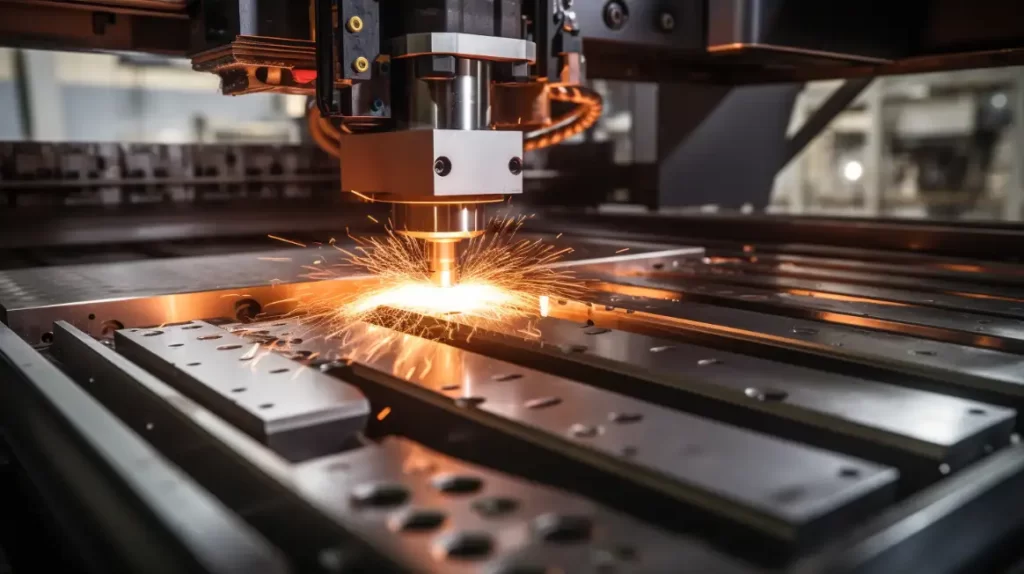
What are the benefits of laser cutting?
Laser cutting is a crucial component of modern manufacturing. It offers a variety of benefits, including unmatched accuracy, lightning-fast speed, flexibility in design, material efficiency, and minimal heat effect.
Precision and Accuracy
There is no room for errors when creating complex and intricate shapes. Laser cutting can achieve tolerances of +-0.005 inch. This level of precision is significant for industries such as aerospace and automotive, where even the slightest mistake can have serious consequences.
Speed up
Speed of production is a crucial factor in a world that values time. Laser cutting allows us to meet deadlines while maintaining quality. What used to take days or hours can be done in minutes with laser cutting.
Flexible Design
Laser cutting has made design limits obsolete. Laser cutting is a great way to create intricate patterns, letters, or images. This allows for a wide range of creative design options and innovation. Manufacturers can move seamlessly from prototype to production.
Material Efficiency
As they say, “Waste not, want nothing.” Laser cutting maximizes material usage, reduces waste, and lowers costs. The ability of the machine to optimize cutting paths allows for maximum material utilization, leading to more cost-effective and sustainable operations.
Minimal Heat Affectation
The Heat Affected Area (HAZ) is an often overlooked benefit of laser cutting. The heat generated by traditional cutting methods can negatively affect the material’s structural integrity. Laser cutting is a fast and accurate method that leaves the material untouched.
What materials can you cut with laser cutting?
You can use laser cutting on various materials, from metals like stainless steel and aluminum to non-metals like wood and plastics, as well as unique materials.
Metals are the backbone of industries.
Laser cutting is a precision tool used to cut metals in any industry, from aerospace to automotive.
Stainless Steel
Stainless steel is a tremendous laser-cut material with excellent anti-corrosion qualities. The automotive, medical, and food industries often use this material. Laser cutting produces parts with intricate details and sharp edges, precisely what stainless steel industries require.
Aluminium
Aluminum is also a metal that can be laser-cut. Aluminum’s lightweight and thermal conductivity makes it a popular choice in the automotive and aerospace industries. Laser cutting is the best way to cut intricate shapes from aluminum sheets.
Non-Metals: The World Beyond Alloys
Remember that laser cutting isn’t just for metals. This technology also applies to a wide range of materials other than metals.
Wood
Wood is a popular material for everything from furniture to art installations. Laser cutting adds an extra level of finesse. The precision of the laser enables cutting even complex patterns without damaging or chipping the material.
Plastics
Laser-cutting plastics such as acrylic and polycarbonate is a great way to make components for many applications. This produces a smooth edge, which often does not require any additional finishing.
Unique Materials: A Touch of Exclusivity
You read that right. Laser cutting doesn’t have to be limited to standard materials. You can also use laser cutting on exotic materials.
Glass
Cutting glass with specialized lasers is possible and provides a smooth, clean finish. Creating customized glassware, decorative pieces, and specialized lenses is possible.
The Leather
People use laser cutting in various fields, from fashion to upholstery. Precision ensures the leather is well-spent. This is important given the price of high-quality leather.

What are the different types of laser-cutting machines?
CO2 lasers, Nd: YAG, and fiber lasers are the three main types of lasers. The advantages of each type are different, and selecting the best one for your project can significantly impact its outcome.
All-Rounder CO2 Laser Cutters
Since their introduction, CO2 lasers have proved excellent machines for all purposes. These machines are particularly adept at cutting, boring, and engraving materials like wood, plastics, and metals.
Benefits of CO2 laser cutters
- Versatility: CO2 lasers work with both metals and non-metallics.
- Quality Finish: These machines leave an edge finish of high quality, which reduces the need for further processing.
- Affordability: They are generally more affordable, which makes them an ideal entry-level product for small businesses or applications with lower demands.
Fiber Laser Cutters – The Metal Specialists
Fiber laser cutters may be new, but they have already carved a niche in the market. This is especially true when it comes to cutting metals.
The advantages of fiber laser cutters
- Efficiency:These machines offer fast cutting speeds and are extremely energy efficient.
- Precision: Fiber lasers are capable of cutting highly intricate shapes and can create tiny holes that are much smaller than what is possible with other types of lasers.
- Low-Maintenance: These products require less maintenance and are more resistant to environmental changes.
Laser Cutters YAG (NdYAG): Heavy Duty Players
Solid-state Nd: YAG Laser Cutters, or YAG Lasers, can cut thick, robust materials.
YAG Laser Cutters: Benefits and Advantages
- Material Versatility: Works on many metals, including reflective metals, which could be problematic with other laser types.
- Durability: These machines are built to last and are ideal for heavy-duty, high-volume operations.
- Dual-Purpose: YAG Lasers are used for engraving and cutting, making them more versatile than CO2 lasers.
What Should you do to prepare for laser cutting: design and setup?
Laser cutting requires a computer-aided design (CAD) program, selecting the project’s best material and the machine’s configuration to achieve optimal performance.
Use CAD Software for Success
First, it would be best to translate your ideas into a language the laser can understand. CAD software is the answer. You can design parts with exact dimensions and intricate details using CAD software.
Benefits of using CAD
- Accuracy:CAD software enables high-precision design and minimizes errors in manual drafting.
- Efficiency: After placing the design in CAD, you can easily modify or resize it, saving time and resources.
- Interoperability: CAD files are easily shared among stakeholders, making collaboration more straightforward and effective.
Selecting the Right Material
Material selection can have a significant impact on the laser-cutting process as well as the final product. Consider material thickness, structural integrity, and how the material reacts to the laser cutting.
The importance of material selection
- Outcome Qualitative: Different material yields a different quality of cuts. The final product will meet your expectations if you choose the suitable material.
- Cost Efficiency: Some materials cut more efficiently than others. This will impact the cost of your overall project.
- Availability: Always ensure you readily have materials for any large-scale project.
Machine Configuration: Setting Stage
Configuring your laser cutter is the next step after selecting your materials and designs. You must set parameters such as cutting speed, laser power, and focal point.
Tips on Machine Configuration
- Tests:Always test your settings on scrap materials to ensure they are optimal.
- Consult Experts: If you are unsure of the configurations for your machine, you should consult professionals who can guide you.
- Safety Protocols: Follow all safety protocols when setting up the device. This will prevent accidents from occurring.
What comes after laser cutting: Post-processing and finishing techniques?
After laser cutting, finishing processes such as cleaning and deburring, surface treatment, and coatings are crucial.
Cleaning and deburring: A Clean Start
A piece may have burrs or residue when it comes out of the laser cutter. Deburring and cleaning are essential steps in preparing the part for its next stage.
Why Clean and Deburr?
- Smooth edges: By removing burrs, the advantage is softer and safer to handle.
- Better adhesion: If you intend to use adhesives or coatings in the future, surfaces must be clean.
- Quality: An immaculately cleaned part will likely pass the quality control test, saving time and resources.
Surface Treatments and coatings: adding the final flourish
Depending on the component’s final use, you may need to apply surface treatments and coatings for improved durability, aesthetics, or functionality.
Types of Surface Coatings and Treatments
- Anodizing: Commonly used on aluminum to provide better corrosion and wear resistance.
- Paint: Excellent for aesthetic reasons and protects against environmental factors.
- Plating: Plating is a plating method that can improve conductivity and aesthetics.
Joining and assembly methods: Putting it all together
Assembly is the next step after parts have been cleaned and treated. Joining methods include welding, riveting, fasteners, and adhesives.
Key Assembly Methods
- Welding: Ideal for joining metal components, providing solid and long-lasting joints.
- Riveting: The aerospace and automotive industries often use this product to create robust, non-permanent joints.
- Adhesives: Bonds are ideal for plastics and composite materials that can’t be welded.
Quality Control and Inspection – The Final Frontier
Quality control is essential. This includes detailed inspections and if needed, additional finishing touches to ensure that the product meets all of the specified criteria.
Importance of quality control
- Consistency: All parts must be consistent regarding quality, dimension, and functionality.
- Conformity: Verifies that the final product meets industry-specific standards and regulations.
- Customer satisfaction: A high-quality product will likely lead to customer happiness, fostering long-term relationships.
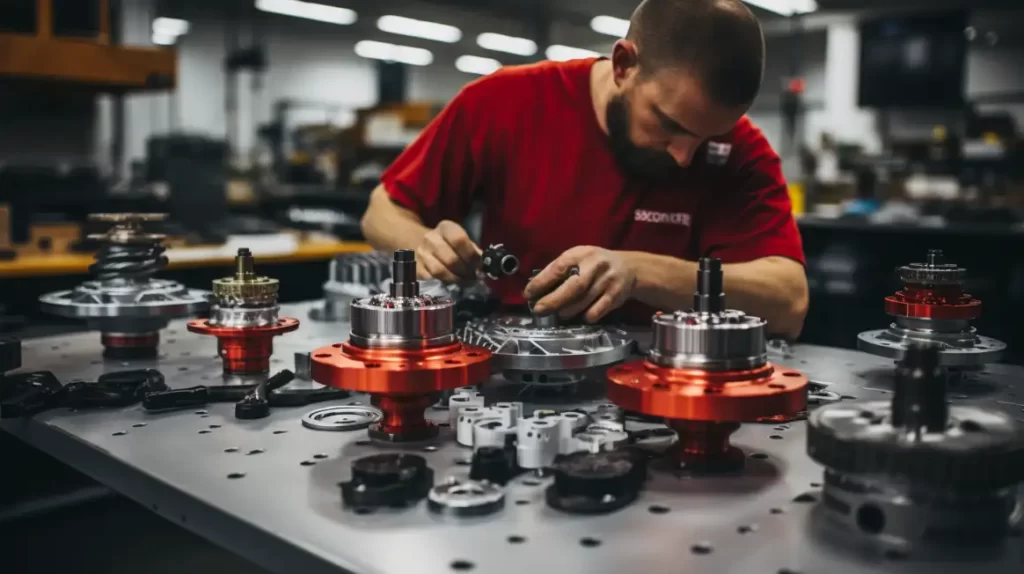
What is the Safety Priority in Laser Cutting
Safety measures in laser cutting are non-negotiable. They include Personal Protective Equipment, machine safety features, and compliance with regulatory guidelines. All of these elements combine to create an efficient and safe work environment.
Personal Protective Equipment: Dress for Safety and Success
Wearing appropriate PPE when operating a laser cutter or just near one is mandatory. It’s not a question of choice; and it’s about safety.
Must Have Personal Protective Equipment
- Safety Eyewear: Protects your eyes against harmful laser rays.
- Heat Resistant Gloves: Protect your hands against potential cuts and burns.
- Ear Protect: Protect against noise hazards in manufacturing environments.
Inbuilt guards: Machine safety features
Modern laser-cutting machines have many safety features that minimize operation risks.
Key Machine Safety Features
- Emergency Stops: Short-access buttons to shut down the machine immediately in an emergency.
- Protective Barriers: Transparent shields to protect from lasers and flying debris.
- Safety interlocks: Designers ensure the device won’t operate until it meets all safety conditions, such as closed doors and activated fume extractors.
Regulatory Guidelines: the Rule Book
It is vital to adhere to the regulatory guidelines for safe operation.
Why follow regulatory guidelines?
- Standardization: Adhering to industry standards such as ISO will ensure a uniform approach to safety.
- Compliance: Non-compliance may result in penalties affecting your company’s finances and reputation.
- Best practices: Guidelines are often the culmination of wisdom and experience from the industry. They direct you to best practices.
What is the role of laser cutting in the industrial world?
Many industries use laser cutting, including aerospace, fashion, and textile sectors. Modern manufacturing is only possible with its accuracy, adaptability, and speed.
Automotive Industry: Gearing up for Excellence
Laser cutting is critical for rapidly and efficiently producing complex components in the automotive industry.
Automotive Industry
- Component fabricationis essential for producing engine parts, body components, and intricate details.
- Customization: You can create limited edition or customized pieces without extensive retooling.
- Prototyping: It is ideal for creating prototypes due to its speed.
The sky is the limit for the Aerospace Industry.
Aerospace materials must be lightweight and robust. Laser cutting is the perfect solution.
Aerospace Applications: Key Applications
- Manufacturing:Manufacturing is essential for producing high-strength and lightweight components such as wing assemblies, turbines, etc.
- Precision: Aerospace tolerances and laser cutting allow for precise measurements.
- Materials: Specialized alloys used in aerospace can be laser cut.
Medical Devices: A Step Above in Care
Laser cutting is an excellent fit for the medical industry, where precision and cleanliness are essential.
Medical Devices: Benefits
- Microcutting: Capable of cutting minimal and complicated components, such as stents or surgery tools.
- Sterility: Laser cutting can be sterile and is essential for medical applications.
- Material Versatility: Can cut various biocompatible materials like titanium and certain plastics.
Textile and Fashion Industry – Crafting the Fabric of Style
Laser cutting is not a traditional application but has found its place in the fashion industry and textiles.
Modern Laser Cutting
- Detailing: Ideal for intricate patterns and designs on leather, synthetic materials, and fabrics.
- Customization: It is ideal for small-batch customized designs.
- Efficiency: It is suitable for fast-paced fashion cycles.
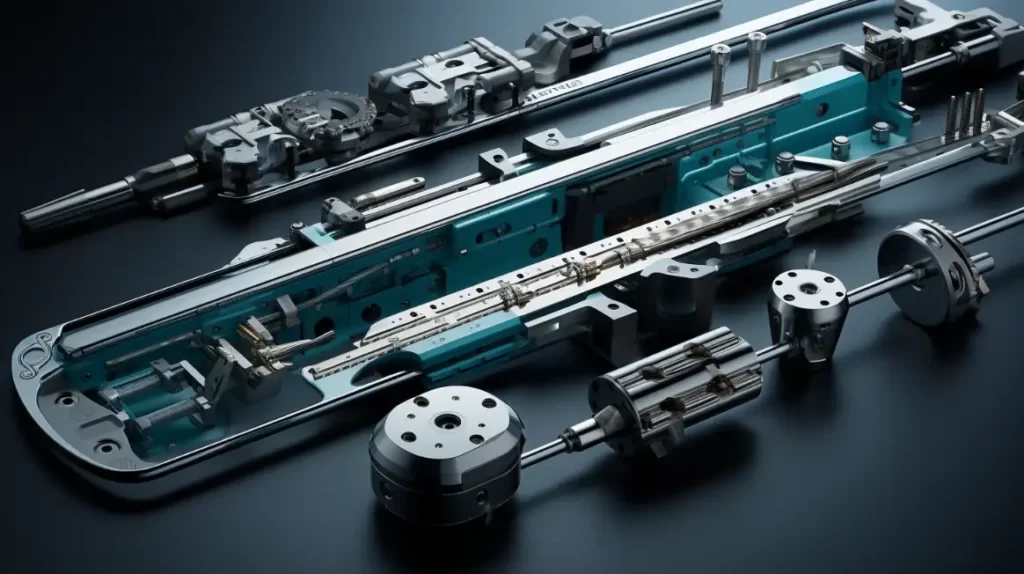
What lies ahead for laser cutting: A glimpse into the future?
Laser cutting has a bright future, thanks to advances in automation, robotics, AI, and a growing emphasis on environmental sustainability.
Automation and Robotics – A Symphony of Efficiency
The role of robotics and automation in laser cutting will become increasingly important as the industry develops.
Why Automation and Robotics?
- Improved Efficiency:Robotic arms, automated feeders, and other technologies can significantly increase the speed of operation.
- Precision: Automation ensures consistent quality, minimizing human error.
- Labor Cost Savings: Reduces the requirement for manual labor and lowers operational costs.
AI and Machine Learning – The Brains Behind the Operation
Laser cutting will become more innovative and adaptive with Artificial Intelligence and Machine Learning integration.
AI Factors in Laser Cutting
- Predictive maintenance: AI algorithms can predict when a machine may fail and allow for proactive maintenance.
- Optimized cutting paths: Machine-learning algorithms can determine the most efficient routes, saving time and materials.
- Quality Assurance: Automated quality checks can be performed in real-time, speeding the production process.
Environmental Concerns and Sustainable Development: A Cleaner Cut
Researchers are examining the environmental impact of laser cutting as we aim for a more environmentally conscious future.
Laser Cutting: The Green Future
- Energy Efficiency: Designers have engineered newer laser-cutting machines to consume less energy.
- Material optimization: Advanced software that maximizes material usage and reduces waste.
- Recyclability and Recycling: The Industry is exploring ways to recycle scrap materials and cuttings more efficiently.
Are you considering laser cutting as a DIY project? What do you need to know?
Laser cutting is a great DIY project! Features like at-home laser cutters, user-friendly software, and safety instructions make laser cutting more accessible to hobbyists.
You can make your laser cutters at home.
There are many laser cutters available for home use. These laser cutters are compact, affordable, and versatile.
What is on offer for home users?
- Price Range: Laser home-cutters can cost anywhere from a few hundred to several thousand dollars.
- Material Compatibility: These machines can cut through wood, acrylic, and thin metals.
- Ease Of Use: They are generally easier to use than industrial machines and therefore accessible to beginners.
Design Like a Pro: Software Options for DIYers
Laser cutting does not require a design degree. Several software programs cater to DIYers.
Popular Software Choices
- Inkscape:Inkscape is a free and open-source vector graphic editor. It’s easy to use.
- TinkerCAD: TinkerCAD is a web-based, beginner-friendly design software.
- CorelDRAW: For users looking for more advanced features and willing to spend money on a professional program.
Safety measures for home use: Better safe than sorry
I should not be compromised because these machines may appear smaller and more straightforward.
Safety Essentials for DIYers
- Ventilation:Ensure a good flow of air in the room. This will disperse any fumes produced during cutting.
- Protective Equipment: Always use safety goggles and gloves that are heat resistant.
- User’s Guide: Before you begin, read all safety instructions and guidelines.
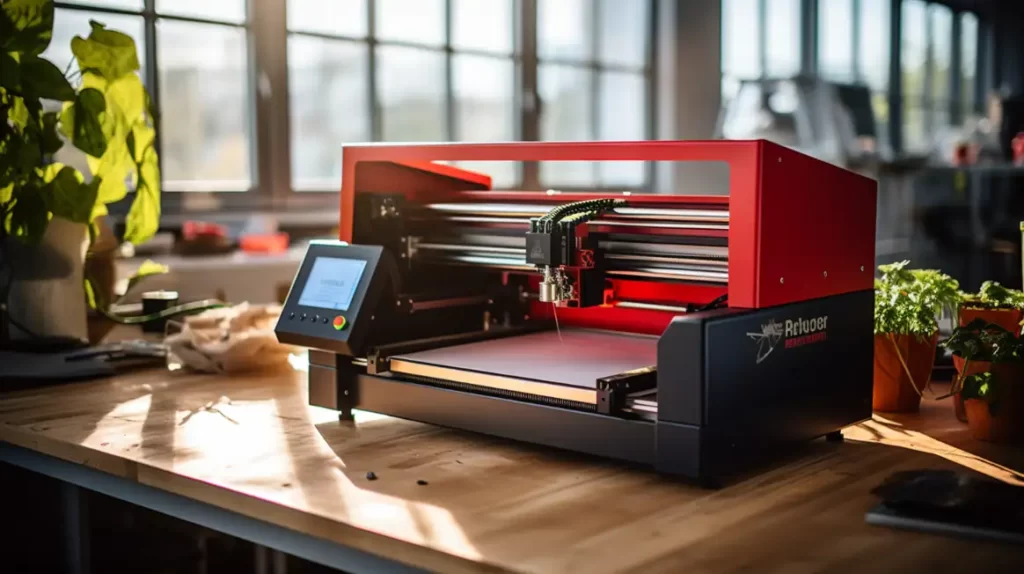
What is the Best Laser Cutting Service?
Focus on cost-effectiveness, quality, and customization when selecting a laser-cutting company. These factors should guide you whether you’re an officer in charge of procurement, a DIY enthusiast, or someone else.
What to look for in a laser cutting service: Speed, Quality, and Trust
Never compromise on quality. There are other factors to consider.
The Essentials of a Reliable Services
- Quality Assurance: Certifications such as ISO 9001 testify to a service’s commitment to quality.
- Turnaround time: In a business setting, speed is essential.
- Customer Service: A knowledgeable and responsive support team can make life easier.
Value over Price: Cost Considerations
Although everyone loves a bargain, focusing on the price alone can be shortsighted.
Balance Cost and Quality
- Volume discounts: Certain services offer discounted prices for bulk purchases, resulting in significant savings.
- Setup fees: Look for initial charges that your unit cost may not cover.
- Shipping & Handling: These costs can quickly increase, especially for international clients.
Customization Options: Our Vision, Your Vision
A good service will be flexible to your needs.
How customizable is the term “customizable?”
- Material range: The service should be able to accommodate your material requirements, whether you require stainless steel, wood, or specialized alloys.
- Flexibility in Design: Ability to create complex designs without compromising quality.
- Finishing options: After-processing treatments such as polishing and coating are available to finish your project.
What are the most common mistakes in laser cutting?
Laser-cutting mistakes include design errors, material selections that must be corrected, and disregarding safety protocols. You can save money, time, and life by avoiding these traps.
Avoiding Design Errors is an Ounce of Precaution
Design errors can cause a lot of problems, and they can affect your whole project.
Avoiding Design Mistakes
- Double-check Dimensions:Always check the dimensions of your design files to ensure they match the actual scale.
- Avoid complex Designs: Complex designs are challenging to cut and can lead to mistakes. Simplicity is best.
- Choose the Right Software: Make sure your design software meets the requirements of the laser cutter. This reduces the chances of file-related errors.
Selecting the wrong material: Be aware of your substances
The wrong material can lead to poor-quality cuts and waste of resources.
Materials Selection Tips
- Research Material Property:Different materials react differently to laser cutting due to their melting points and density.
- Consult experts: Consult with experts if you are unsure about the best material for your project. Shengen is always willing to help you.
- Make Test Cuts: Before running a complete job, a test cut will help you determine if the materials suit your project.
Ignoring safety protocols: Safety First, Always.
Laser cutters are potent machines. Neglecting safety protocols could lead to accidents and damages.
Safety measures to keep in mind
- Protective Equipment: Always use safety goggles and gloves that are heat resistant.
- Ventilation: Ensure adequate ventilation for the dispersion of any fumes produced during cutting.
- User’s Manual: Always read and follow the instructions in the manual.
Laser Cutting Vs. Other Cutting Techniques: Which is Right for You
Laser cutting techniques are a versatile, fast, and precise cutting method. Plasma, water jet, and mechanical cutting have advantages but also limitations. The specific needs of your project should guide your choice.
Plasma Cutting is Hot but Limited
Many industries use plasma cutting, although it’s a cumbersome process. How does it compare with laser cutting?
Plasma Cutting: Pros and cons
- Cutting speed: Generally, it is faster than mechanical but slower than laser.
- Material limitations: Best for conductive materials such as metals, which limits its versatility.
- Precision: Less precise cutting than laser, with wider kerfs.
Water jet cutting: excellent but messy
It uses a high-pressure stream of water with or without abrasives to cut through the material.
Water Jet Cutting: Advantages and disadvantages
- Material range: Suitable for materials sensitive to high temperatures, such as glass and rubber.
- Cutting speed: In general, slower than laser and plasma cutting.
- Work Environment: Using water can make the environment messy and require additional cleaning.
Mechanical Cutting: An Old Gold?
People have used mechanical cutting methods like shearing and sawing for ages. Are they still viable?
Strengths and weaknesses of mechanical cutting
- Equipment cost: Initial setup is generally less expensive.
- Speed: Speed is often slower and less accurate than laser or plasma cuts.
- Material waste: Produces more material waste than laser cutting.
conclusion
Laser cutting is a technology that has become a leader in material processing. Its importance will continue to grow in the future. We at Shengen pride ourselves on staying on the cutting edge of technology, providing the most reliable and advanced laser-cutting solutions to meet your needs.
Do you need a reliable sheet metal parts manufacturer? Shengen is the place to go. We specialize in sheet metal laser cutting, bending, surface finish, and sheet metal welding. We place a high priority on establishing trust, maintaining standards of quality, providing competitive prices, and guaranteeing timely delivery.
More Resources:
For standard safety guidelines in laser cutting – Source: OSHA
The environmental impact of laser cutting – Source: JQLASER
Hey, I'm Kevin Lee

For the past 10 years, I’ve been immersed in various forms of sheet metal fabrication, sharing cool insights here from my experiences across diverse workshops.
Get in touch

Kevin Lee
I have over ten years of professional experience in sheet metal fabrication, specializing in laser cutting, bending, welding, and surface treatment techniques. As the Technical Director at Shengen, I am committed to solving complex manufacturing challenges and driving innovation and quality in each project.


